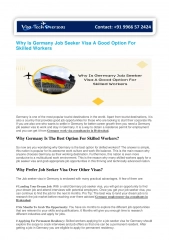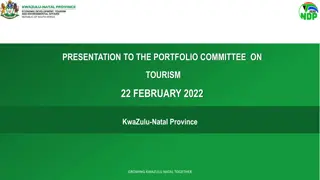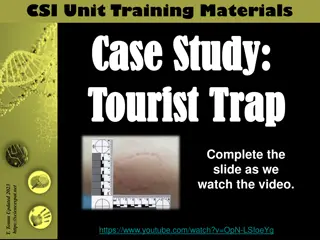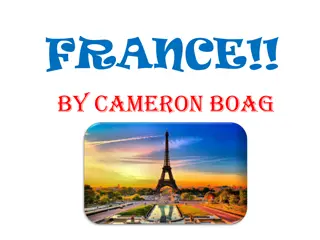Enhancing Tourist Experiences Through Information Technology
Explore the pivotal role of Information Technology (IT) in attracting visitors to attractions and events, staging memorable experiences, and managing visitor interactions. Delve into key concepts such as augmented reality, gamification, and electronic ticketing systems, while understanding attractions from natural wonders to cultural sites. Discover how IT solutions like mobile apps and mediawalls aid in attracting visitors, enhancing experiences, and enriching the tourism industry.
Download Presentation

Please find below an Image/Link to download the presentation.
The content on the website is provided AS IS for your information and personal use only. It may not be sold, licensed, or shared on other websites without obtaining consent from the author.If you encounter any issues during the download, it is possible that the publisher has removed the file from their server.
You are allowed to download the files provided on this website for personal or commercial use, subject to the condition that they are used lawfully. All files are the property of their respective owners.
The content on the website is provided AS IS for your information and personal use only. It may not be sold, licensed, or shared on other websites without obtaining consent from the author.
E N D
Presentation Transcript
2ndEdition Tourism Information Technology PIERRE J. BENCKENDORFF PAULINE J. SHELDON DANIEL R. FESENMAIER
Chapter 10 Tourist Experiences and Information Technology
Chapter 10 Learning Objectives After studying this chapter you should be able to: 1. explain the role that IT plays in attracting visitors to attractions and events; 2. analyze the different roles of IT in the staging of memorable attraction and event experiences; 3. understand how It can disrupt or destroy some visitor experiences; and 4. apply various IT solutions to the management of visitors in attraction and event settings.
Key Concepts Android, animatronics, mechatronics Augmented and virtual reality Electronic ticketing systems Experience economy Gamification Interpretation and orientation Virtual guide Virtual queuing systems 4
Understanding Attractions Natural Cultural flora and fauna terrestrial/marine parks & reserves landscapes geological features theme parks art galleries & museums historic sites architectural wonders zoos & aquaria sports & entertainment sites shopping & tourist precincts sports events festivals concerts & performances conferences & meetings Permanent volcanic eruptions astronomical events wildlife migrations coral spawning Temporary 5
Attracting Visitors Visitor Information Centers (VICs) Mobile apps Mediawalls Twitter feeds Information kiosks Tablets Sales and distribution Electronic ticketing 6
Staging Experiences Role Enabler Description Technological innovations stimulate travel demand by providing the inspiration, time and economic means for people to travel Technology is used in the creation of tourism experiences and settings Technology can be the focal point for travel experiences Technology can enhance the experience by supporting comfort, orientation, interpretation and translation Technology can be used to protect travelers and the resources that attract them Technology can reveal meanings and understandings of objects, artifacts, landscapes and sites through interpretation Technology can provide visitors with substitute experiences in instances where the resource is threatened, congested or not accessible Technology is a tool for the tourism industry Technology can be used to support the recording, reflection and sharing of experiences Technology can also destroy the experience by impacting the social, environmental and economic well-being of travelers or employees Creator Attractor Enhancer Protector Educator Substitute Facilitator Reminder Destroyer
Technology as an enabler Technology stimulates the broader socio-economic conditions for travel; increases productivity and relieves workers from mundane tasks; enables the movement of travelers; is used extensively in the production and delivery of goods and services; and has provided easy access to travel information. 8
Technology as a creator Engineers, architects and other professionals use CAD software to design tourism facilities. Technological infrastructures and machines create new opportunities for tourist experiences. Examples: jet boating jet skiing Segway tours simulators roller coasters ski runs 9
Technology as an attractor Technology may be the focus of the experience that attracts visitors. Examples: science and technology museums (e.g. EPCOT) industrial sites (e.g. Guinness Brewery) working farms (e.g. Dole Pineapple Plantation) technology expos and motor shows theme park rides audio-visual effects augmented and virtual reality 10
Technology as an enhancer visitor orientation translation communication and translation planning and scheduling 11
Technology as a protector Protection of travelers: electronic locking systems surveillance systems security scanning warnings sent to mobile devices water treatment and food safety Protection of resources: climate control systems documenting historical and natural artifacts monitoring and managing wildlife energy and waste management 12
Technology as an educator Interpretation and edutainment: virtual guides, audio guides & podcasts mobile technologies (QR codes, geofencing, wearable technologies) special effects virtual and augmented reality holographic projection 3D printing robotics and mechatronics interactive surfaces 13
Technology as a substitute Technology can re-enact or recreate environments, activities or events to provide substitute experiences for: fragile or dangerous places experiences that are too costly attractions and objects that no longer exist visitors with disabilities or mobility constraints 14
Technology as a facilitator Applications Technology Examples Marketing & distribution Websites, online bookings, apps, on-site purchases Visitor management Managing access, managing queues and crowding Business intelligence Tracking visitor patterns and behavior Facility management Property management systems, safety and security Back-office systems Revenue management, accounting, payroll systems Personnel Employee access systems, laundry and costuming services Automation Cleaning, order taking, self-service kiosks, robotics 15
Technology as a reminder Visitors use IT to document, capture and share experiences. Examples: image and video sharing geotagged images social media product reviews blogs 16
Technology as a destroyer Technology can also bite back, resulting in negative experiences, inconvenience or more serious consequences: technology failure noise and visual pollution resource depletion 17
Managing Visitors Admission Smart cards, wristbands, barcoded tickets, biometrics, seat allocation LCD maps and directories, mobile apps Cashless payment systems for parking, accommodation, food and beverages, photos and merchandize; geofencing and mobile notifications Visitor tracking, controlled access, forecasting demand, virtual queuing systems, wait time displays, queue entertainment Strategic listening, monitoring visitor behavior Orientation Ancillary purchases Crowding & queue Management Business intelligence & CRM Safety & security Casinos & gaming CCTV, secure access, electronic lockers, safety systems Slot machine maintenance and accounting, table games, player tracking and marketing, cage management, and staff systems
Discussion Questions 1. What technologies do you use when you are traveling? How can technology be used in the co-creation of visitor experiences? 2. Some commentators have predicted that virtual reality will eventually eliminate the need to travel. Do you think this is a valid prediction? Discuss your reasoning. 3. Think about places you have visited on your travels. Have you experienced any examples of technology in interpretive experiences? Were these technologies effective in supporting your learning or were they just a gimmick? 19
Discussion Questions 4. In this chapter we explored some of the challenges and opportunities of using IT for interpretation. What are some of the operational advantages and disadvantages of using technology in the creation of experiences? 5. Does the use of technology in attractions erode or enhance opportunities for high touch experiences? Discuss your reasoning and compare your points with other students. 20
Useful Websites International Association of Amusement Parks and Attractions www.iaapa.org International Council of Museums icom.museum PDC www.pdcsolutions.com Accesso accesso.com iVenture Card www.iventurecard.com Walt Disney Company thewaltdisneycompany.com 21
Case Study: Walt Disney Company Any sufficiently advanced technology is indistinguishable from magic (Arthur C. Clarke). Walt Disney Parks and Resorts include six destinations with 13 theme parks and 46 resorts in North America, Europe and Asia. Walt Disney was an early pioneer in the adoption of new technologies for animation, live action films, nature documentaries, special exhibits, theme park rides and city planning. MyMagic+ My Disney Experience website and mobile app. MagicBand RFID wristband. Provides theme park entry, hotel room access, purchases, dinner reservations, fastpass and photopass access, and various interactive experiences. 22























